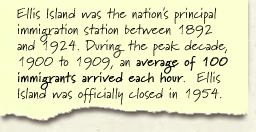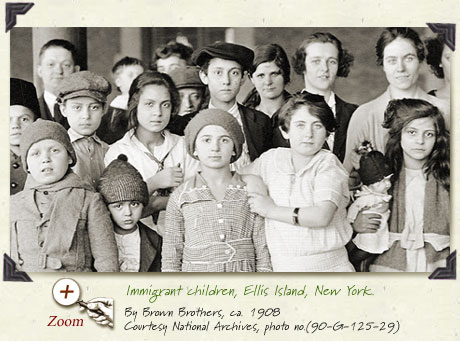
The United States has always been home to immigrants. Scientists
believe the first were Native Americans who came to North America
thousands of years ago from Asia.
![Immigrants - Ellis Island [between 1907 and 1917] From: Selected Images of Ellis Island & Immigration, ca. 1880-1920, from the Prints & Photographs Division of the Library of Congress](immig_ellis_fence.jpg)
After European explorers discovered they could travel around the
world, settlers from Europe began to move to America. As the country
changed from a colonial property of England to an independent country,
more settlers came to live in America. While the number of people
coming to America from other countries has varied from year to year,
America has always been home to immigrants from countries around the
world.
Between 1820 and 1930 about 60 percent of the world’s immigrants
came to live in the United States.

During most of this time, farming and industry were growing very
rapidly. As large sections of the Midwestern and Western states became
open for pioneer settlement, immigrants found opportunities to own
land and build homes as Americans.
As the Midwest and western territories of the United States were
opening up for settlement, not all new immigrants became farmers.
Some settled in towns and cities where they found work in factories
and businesses.
Like a snowball rolling down a hill, business and industry recruited
immigrants to come to America to work in factories and businesses.
As more people arrived businesses expanded as the demand for factory
goods grew. This pattern was followed as Iowa developed into an agricultural
and industrial region.

As Waterloo developed into an established community, the city’s
industries developed as well. When the railroad arrived in Waterloo
on March 11, 1861, the city grew even faster.
Farm products and factory goods could now be transported to the Mississippi
River quickly and efficiently. They could be moved by rail to states
to the east and west as well. In a single day, the railroad could
now carry passengers to locations that before would have required
several day’s travel.
As industries expanded, new workers were needed. At first, local
farmers and transient laborers filled these jobs.
But by 1890, many European immigrants were being attracted to Waterloo
to work in the factories. Often they came from small villages, sometimes
in the same region, which provided a common bond.

Nearly everyone used family connections and friends to obtain jobs.
They worked in railroad shops and meatpacking. They helped build farm
equipment. Some worked in paving and construction. Others worked in
machine shops and foundries. Still others worked in the wholesale
trade.
Waterloo welcomed immigrants from many countries including Italy,
Germany, Ireland, Denmark, Greece, Mexico, Croatia, Bulgaria and Russia—to
name just a few.
But not all new people moving to Waterloo came from Europe. Many
moved to Iowa from states to the east. Still others came from the
south. In 1912 for example, many African American people arrived in
Waterloo from Mississippi to work for the Illinois Central Railroad.
By 1920 the city had attracted immigrants from twenty nations. By
1925 the total foreign born was 4254, 12% of the city's population.
The new arrivals lived in working class areas close to the factories
and streetcar lines. At first, most were single men who came with
the intention of bringing their families later. Some lived in boxcars
in the train yards.
At first most cultural groups maintained their individual identities.
The ethnic neighborhoods they formed were a blend of different languages,
exotic foods, and new forms of dress.
In the homes and neighborhoods, language and cultural traits could
be retained, but the workplace demanded English. As a result, the
sharp cultural lines that defined groups began to blur as a common
language and common work place worked to assimilate some groups together
forming a new community.
But how these new immigrants assimilated varied from group to group
and changed over time. For example, still today the religious diversity
of the early immigrants to Waterloo can be seen in the names of religious
houses of worship. St. Demetrios Greek Orthodox Church, the Sons of
Jacob Jewish Synagogue and the African Methodist Episcopal Church
reflect strong cultural ties to this day.
Some groups including African Americans and members of the Jewish
community were confronted with racism and social isolation. Restricted
covenants in housing, for example, kept members of these groups from
buying property outside a very restricted area. Job discrimination
also reduced the number of jobs they could be hired to do.

|



